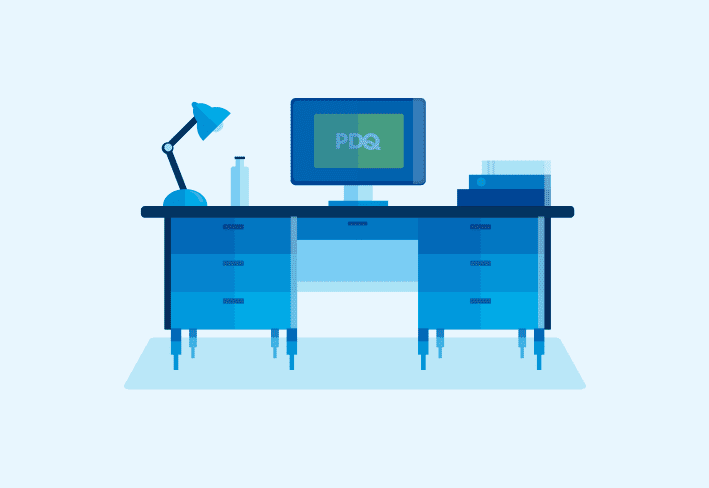Here to learn how to deploy Microsoft Office 365 to your devices? We’ve got you covered with PDQ Deploy and PDQ Connect.
The process to deploy Office 365 is a bit different from how the process normally works with our packages. Instead of a package in PDQ Deploy, we offer a template that includes the (silent!) install parameters but not the setup file itself.
The setup file comes straight from Microsoft via its Office Deployment Tool. Why? Because offering the actual setup file from Microsoft in a convenient package would technically violate Microsoft’s EULA. ‘Cause, you know, it's not like you need a license key or anything to actually use the software ...
Anyway, let’s get to it. In four steps that are far less complicated than figuring out what to o̶r̶d̶e̶r̶ make for dinner, you’ll have Office 365 running on the devices in your fleet.
PDQ Deploy
Download the Office Deployment Tool.
Generate a configuration file.
Download and run the template from the Package Library in PDQ Deploy.
Deploy Office 365 across your on-prem devices.
PDQ Connect
Download the Office Deployment Tool.
Generate a configuration file.
Create a new package from the PDQ Connect console.
Deploy Office 365 across your remote devices.
Let’s do it!
Centralize your Windows device management
With PDQ Connect, gain real-time visibility, deploy software, remediate vulnerabilities, schedule reports, automate maintenance tasks, and access remote devices from one easy-to-use platform.
Use PDQ Deploy to install Office 365
Below are the instructions that explain how to deploy Office 365 with PDQ Deploy. A few steps require some additional explanation, so I’ll note those steps clearly in these instructions. Feel free to bounce back and forth as you need to.
1. Download the Office Deployment Tool.
2. Run the downloaded file.
3. Overwrite all the files in C:\Users\Public\Documents\Admin Arsenal\PDQ Deploy\Repository\PDQTemplates\Office365.
4. Open a browser and launch the Office Customization Tool.
5. Generate and export your configuration file, overwriting the existing file in C:\Users\Public\Public Documents\Admin Arsenal\PDQ Deploy\Repository\PDQTemplates\Office365\.
(Please see the next section for instructions and best practices for generating your configuration file using the Office Customization Tool.)
Please skip step 6 if you chose Office Content Delivery Network (CDN) while configuring the Office Customization Tool.
6. If you chose local source in your configuration options, open an elevated PowerShell window and run the following command (including the quotation marks):
“C:\Users\Public\Documents\Admin Arsenal\PDQ Deploy\Repository\PDQTemplates\Office365\setup.exe /download configuration.xml”
Note: Because the Office installation files are not technically associated with the package, if you keep your Office installation files in your PDQ Deploy repository, make sure you exclude the files and/or directory that contains these files from the PDQ Deploy Repository Cleanup.
You can find this setting in Options > Preferences > Repository > See Unused Files. In the Repository Cleanup menu, find and highlight the Office installation files (or the directory they are present in) and select either Exclude File(s) or Exclude Directory.
This is not applicable if you chose Office Content Delivery Network (CDN) for the source files or if you don’t store your Office installation files in your PDQ Deploy repository.
7. In the PDQ Deploy console, download the TEMPLATE – Office 365 / Office 2019 / Office 2021 template from the Package Library.
8. Navigate to the install step in the package. Make sure the paths and file names are correct for your instance.
9. Deploy the package to a few clients for testing purposes. If all looks good post-deployment, deploy to your heart’s content!
Generate the Office 365 configuration file
To generate the Office 365 configuration file, we can use the Office Customization Tool. This tool generates configuration XML files for the Office 365 suite. It’s an extremely flexible, well-designed tool, but there are options that are easy to miss. Some of these options are necessary for a successful silent installation.
Fortunately, we’ve tested plenty and have quick lists of both required and recommended settings, along with explanations for each.
The list of required settings is short.
1. Products and releases > Products: Surprise, surprise — you have to identify which product(s) you want to install. In this example, I’ll select Microsoft 365 Apps for business.
2. Language > Languages: You must select a language for the installation. You can specify one or more fixed languages, or you can select Match Operating System, which defaults to the locale on the target machine.
If you run the download on a machine with a different locale than the target machine, the installer will reach out to the Office Content Delivery Network (CDN) for the missing language files.
3. Installation > Installation Options > Show installation to user: You’re never gonna guess what this does. Change it to Off. This one’s easy to miss.
4. Licensing and activation > Automatically accept the EULA: This is the other setting that is required specifically for a silent install. We don’t want to have to click through a prompt to accept a EULA. Simply change this to On.
While these are the only settings that are absolutely critical for a silent installation, I implore you read our recommended settings, or you’re likely in for a world of hurt. And we have enough of that in IT. 😅
Recommended settings
1. Installation > Installation Options > Source: By default, the configuration file generated by the Office Customization Tool tells the installer to pull down a copy of the Office installation files from the Office CDN. This is a waste of bandwidth and will destroy your office’s internet connection should you push it to a large chunk of your fleet. Select Local Source and enter a fixed UNC path.
In our example, let’s set it to a folder in our Deploy repository. This provides a consistent, reliable location that the installer can pull the source files from, as both the download and installation processes use the same path setting.
This needs to be an absolute path. Relative paths and environment variables won’t work, and your deployment will fail if you try to use them. I highly recommend using the UNC path to your Deploy repository. You need to ensure your Deploy user can access this location, as the installer runs in the context of that account.
Absolute vs. relative paths
In case you need a refresher, an absolute path is a specific path that starts at the root directory (e.g., C:\) and ends at a specific file or folder (e.g., the repository folder). A relative path starts wherever you currently are in the directory and references a file or folder that’s close by.
For example, an absolute path looks like this:
C:\Users\Public\Documents\Admin Arsenal\PDQ Deploy\Repository
And a relative path looks like this:
.\Repository\setup.exe
2. Products and releases > Architecture: This is set to 64-bit by default. Microsoft recommends installing the 32-bit version when the devices in your fleet meet at least one of the following criteria:
They’re running 64-bit Windows 10 with an ARM-based processor
They’re running a 32-bit operating system with a 32-bit processor
They have less than 4 GB of RAM
But if your devices overfloweth with processing power and memory, the 64-bit should work fine.
3. Products and releases > Update channel: This determines how frequently you receive Microsoft Office updates. Microsoft recommends going with the Current Channel option because this option keeps your Microsoft Office 365 instances updated to the latest version. However, if you’re more of a “let’s test this out and then deploy it” kinda person, you might prefer the Semi-Annual Enterprise Channel. Somewhere in the middle? Choose the Monthly Enterprise Channel (and say a prayer to the tech gods every Patch Tuesday).
Once you’ve configured all these settings, hit the Export button in the top-right corner and save the resulting XML file somewhere safe. For our purposes here, let's call it configuration.xml.
Use PDQ Connect to install Office 365
If you’re in a remote or hybrid environment, never fear: PDQ Connect can help you deploy Office 365, too. 😊
We currently don’t have a dedicated package to deploy Office 365 using PDQ Connect. (But if this is a feature you’d love to see, please let us know!) Let’s walk through how to create a package to install Office 365 via PDQ Connect.
Important note: When you create your configuration file using the Microsoft Customization Tool, set the download source to Office CDN.
1. Download the Office Deployment Tool.
2. Go through the steps outlined above to create your configuration file. Again, be sure to set the download source to Office CDN!
3. In the PDQ Connect console, click Packages, then Create package.
4. Give your package a name. My creative muse tells me to call mine Install Office 365.
5. Click the Add install step button to the left of the panel.
6. Enter the information as it’s displayed in the screenshot below. Be sure to attach the installer (setup.exe) as the installer and your configuration file as an attachment.
Feel free to copy the below code and paste it into the Parameters field. No lie — I spent an entire day troubleshooting why my package refused to deploy. Turns out, I'd made a mistake in my parameters. (How? It's two words.) Don't be a Rachel. 😅
/configure Configuration.xml
7. Click Save. Your package is ready to deploy!
8. From the Connect console, click Deployments, and then the Deploy button at the top right of the screen.
9. In the Search packages field, type in the name you gave your package in step 4.
10. Choose your devices or device group to deploy to.
11. Click Deploy.
Congrats! You should now have Office 365 installed on your devices. I hope this tutorial made your deployments fast and free of headaches. Now, the Microsoft products you just installed, on the other hand ... well, I can’t help you there. 😅
If you read this far, you’re likely already one of our partners — but if you’re not, mad respect for reading this product-focused piece. 😂 You can always download a free trial of PDQ Deploy or PDQ Connect. We have hundreds of prebuilt packages ready for you to deploy to your devices.
Happy deploying!




